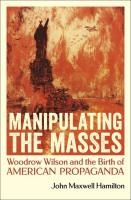""The Birth of American Propaganda" is about a profound and enduring threat to American democracy that arose out of World War I: the establishment of pervasive, systematic propaganda as an instrument of the state. During the Great War, the federal government exercised unprecedented power to shape the views and attitudes of American citizens. Its agent for this was the Committee on Public Information (CPI), which was established by President Woodrow Wilson on April 14, 1917, one week after the United States entered the Great War. Under the energetic efforts of George Creel, the CPI established a national newspaper (the Official Bulletin), cranked out press releases, and interfaced with the press at all hours of the day. The CPI spread its messages through articles, cartoons, books, and advertisements in newspapers and magazines; through feature films it produced; through posters plastered on buildings or displayed in storefront windows; and through pamphlets distributed by the millions. The CPI established organizations to reach members of labor unions and recent immigrants to the States. It mobilized the nation's leading advertising executives and artists. It harnessed American universities and their professors to create propaganda and add legitimacy to it. It had partnerships with the Council of National Defense and other patriotic organizations determined to pull the country together. Even as Creel insisted the CPI was a conduit for reliable information, the CPI employed non-consensual strategies that worked against the democratic ideals it espoused. It sanitized news and distorted facts. It appealed to emotions of home and hearth, but aroused fear and hatred. Creel extolled transparency but worked through front organizations and supplied news without identifying it as CPI propaganda. Overseas the CPI secretly subsidized news organizations and bribed journalists. In its zeal to discredit the fledgling Bolshevik government in Russia, it became the conduit for forged documents that purported to show Vladimir Lenin and his comrades were German agents. The CPI's publication of these-a classic disinformation campaign-worsened relations with the new regime and helped fuel the Red Scare. The CPI had alliances with some of the most viciously patriotic societies in the country. Working closely with federal intelligence agencies eager to sniff out subversives and stifle dissent, the CPI was an accomplice to the Wilson administrations' trampling of civil liberties. Until now, the full story and legacy of the CPI has never been told. John Maxwell Hamilton has consulted over 150 archival collections in the United States and Europe to provide precisely that comprehensive history. The mindset and techniques used by the CPI are written indelibly on modern America. Every element of contemporary government propaganda has antecedents in the CPI. It is the ideal vehicle for understanding the rise of propaganda and its methods of operation, the emergence of the imperial presidency in the twentieth century, and the threat propaganda poses to democracy"--

